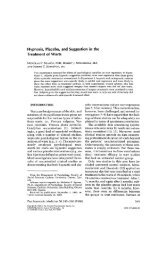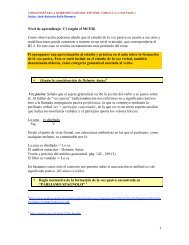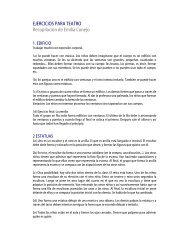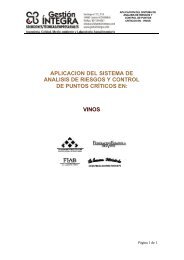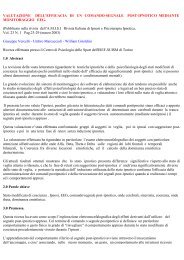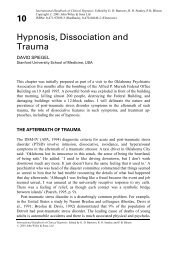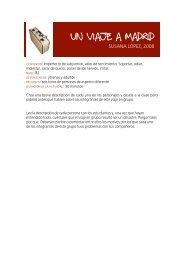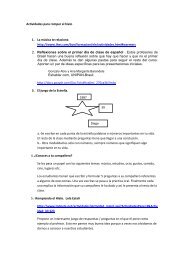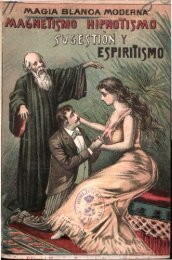Diccionario etimológico comparado de la lengua castellana
Diccionario etimológico comparado de la lengua castellana
Diccionario etimológico comparado de la lengua castellana
Create successful ePaper yourself
Turn your PDF publications into a flip-book with our unique Google optimized e-Paper software.
I<br />
FA FABA 2527<br />
La / no se encuentra en <strong>la</strong>s raíces<br />
vascas, y sólo en algunas pa<strong>la</strong>bras extranjeras,<br />
como en faborea <strong>de</strong>l esp.<br />
favor: se cambia en /¿, como en iiuni<strong>la</strong><br />
<strong>de</strong>l esp. fonil; en p como en portatu<br />
<strong>de</strong>l esp. forzar, ó en 6, como en breza<br />
<strong>de</strong>l esp. freza. En francés se hal<strong>la</strong>n<br />
liors por fors <strong>de</strong> foris; habler <strong>de</strong>l esp.<br />
hab<strong>la</strong>r; harouce (ant.). {)or farouche y<br />
hausart (ant.), por fausart. En vá<strong>la</strong>co<br />
existe el mismo cambio <strong>de</strong> / en /¿,<br />
como: han <strong>de</strong> faniim^ he'hle'i <strong>de</strong> fabu-<br />
<strong>la</strong>ri, etc.<br />
Aunque raramente, <strong>la</strong> f suele cambiarse<br />
en sus correspondientes <strong>la</strong>biales<br />
6 y /), como en ital. bióccolo <strong>de</strong>jloccus;<br />
FOR-B-iCE <strong>de</strong> for-f-ex; esp. á-b-rego <strong>de</strong><br />
africus; cuébano <strong>de</strong> cophinus ; port.<br />
TREVo <strong>de</strong> trifolium; ábrego <strong>de</strong> africus,<br />
etc.; cfr. en italiano colpo <strong>de</strong> cóLaphus;<br />
esp. ORESPE por orífice; sop<strong>la</strong>r por<br />
sof<strong>la</strong>r; (ital. soffiaré); port. napja por<br />
nafta; prov. colp <strong>de</strong> có<strong>la</strong>phus, etc.<br />
Raras veces <strong>de</strong>saparece <strong>la</strong> / ó <strong>la</strong> espirada<br />
h por síncopa. Cfr. ital. sione<br />
por sifone; esp. <strong>de</strong>sol<strong>la</strong>r por <strong>de</strong>shol<strong>la</strong>r<br />
<strong>de</strong> <strong>de</strong>sfol<strong>la</strong>r; prov. conortar <strong>de</strong> confortar;<br />
franc. écrouelle <strong>de</strong> s erófu<strong>la</strong>, etc.<br />
El grupo ff <strong>de</strong> los compuestos se reduce<br />
á <strong>la</strong> simple f, como en diferir<br />
<strong>de</strong> differire, ofen<strong>de</strong>r, <strong>de</strong> offen<strong>de</strong>re, etc.<br />
Se exceptúa ahogar <strong>de</strong> creación mo<strong>de</strong>rna,<br />
pues no existe en <strong>la</strong>lín el verbo<br />
ajfocare <strong>de</strong> ad-focare.<br />
El grupo Jl suele cambiarse en //.• cfr.<br />
l<strong>la</strong>ma <strong>de</strong> f<strong>la</strong>mma; sol<strong>la</strong>r (ant.), <strong>de</strong><br />
sujf<strong>la</strong>re, etc.<br />
En <strong>la</strong>t. F. pue<strong>de</strong> significar fílius^ frater,<br />
familia, fecit, etc. y FL significa<br />
F<strong>la</strong>vius. Se marcaban con una F en<br />
<strong>la</strong> frente los esc<strong>la</strong>vos, que se escapaban<br />
y eran aprehendidos, significando fugitiüus.<br />
En Francia, antes <strong>de</strong> 1831, se marcaba<br />
<strong>de</strong>l mismo modo á los falsarios.<br />
En <strong>la</strong> numeración <strong>la</strong>tina F <strong>de</strong>notaba<br />
40 y, con una rayita encima, 40.000.<br />
En jurispru<strong>de</strong>ncia ff significa Digesto<br />
y en Comercio /'quiere <strong>de</strong>cir folio,<br />
(cfr. F. Diez Gram.).<br />
SIGN.—Séptima letra <strong>de</strong>l abecedario castel<strong>la</strong>no,<br />
y quinta <strong>de</strong> sus consonantes. Su nombre<br />
es EFE.<br />
Fa. m.<br />
ETIM.— Es <strong>la</strong> primera sí<strong>la</strong>ba <strong>de</strong> famuli,<br />
perteneciente á <strong>la</strong> primera estrofa<br />
<strong>de</strong>l himno <strong>de</strong> San Juan Bautista, <strong>de</strong><br />
don<strong>de</strong> fueron sacados también los nombres<br />
<strong>de</strong> <strong>la</strong>s <strong>de</strong>más notas musicales por<br />
Guido Aretino. El himno empieza así:<br />
Ut queant <strong>la</strong>-x'is /'e-sonare fibris<br />
Mi-ra gestorum /á-muli tuorum,<br />
Sol-ve polluti <strong>la</strong>bii reatum ....<br />
Las notas fueron, pues, primitivamente<br />
<strong>la</strong>s seis siguientes:<br />
SIGN.<br />
—<br />
uty <strong>la</strong>, re, mi, Ja, sol.<br />
Mus. Cuarta voz <strong>de</strong> <strong>la</strong> esca<strong>la</strong> música.<br />
Fab-a. f.<br />
ETIM.— Del <strong>la</strong>t. fab-a, haba y otras<br />
muchas especies <strong>de</strong> legumbres y bayas;<br />
<strong>de</strong>rivado <strong>de</strong>l primit. *fag-üa, y éste <strong>de</strong><br />
*fag-ua, cuyo cambio <strong>de</strong> -g- en -b- cfr.<br />
en ar-bi-ter, por ^ar-gci-ter, primit. <strong>de</strong><br />
ÁR-BiTRO. Sírvele <strong>de</strong> base <strong>la</strong> raíz fab-,<br />
<strong>de</strong> <strong>la</strong> primitiva fag-, y ésta <strong>de</strong> <strong>la</strong> indoeuropea<br />
BHAG-, distribuir, repartir; gozar,<br />
disfrutar, fruir, sacar provecho;<br />
tomar alimento, comer; correspondiente<br />
á <strong>la</strong>s raíces sánscritas bhag'-, y bhak-s-,<br />
comer, tomar alimento. Cfr. skt. ^Tt,<br />
bhaksh, comer, <strong>de</strong>vorar, tragar, engullir,<br />
alimentarse, tomar alimento; grg.<br />
'faa-YjXo-? (= *aía^-Y¡)vo-;), habichue<strong>la</strong>; skt.<br />
vjsT, bhag', comer ; griego '¿«7-, comer<br />
'fay-e^v, (aor. 2.»), haber comido, e^ay-ov<br />
(aor. 2.0), comí, comieron; 'fáy-o?, el que<br />
come (en composición, cfr. ávepwTió-'fay-o?,<br />
antropófago); o-qy-ác^ = \aí. fag-us, haya,<br />
árbol, encina que produce bellotas comestibles<br />
(<strong>de</strong>l cual se <strong>de</strong>rivan fag-eus,<br />
-ea, -eum; fag-in-us, -a, -um, y fag-ineus,<br />
-ea, -eum, perteneciente á <strong>la</strong> encina);<br />
ingl. beech, haya; isl. bok, haya, árbol<br />
sueco bok; dan. bóg ; holán, beuk; al.<br />
buche; ant. al. a!, puohha ; ruso buk',<br />
etc. Cfr. ingl. book, libro, volumen escrito<br />
(así l<strong>la</strong>mado, porque los primeros libros<br />
fueron escritos en tablil<strong>la</strong>s <strong>de</strong> haya),<br />
al que correspon<strong>de</strong>n : anglo-saj. búc;<br />
hol. boek; isl. bók; sueco bok; dan. 60^;<br />
ant. al. al. buah; med. al. al. buoch; al.<br />
buch, etc. Cfr. ingl. bean, haba; anglosaj.<br />
beán ; isl. baun; ant. al. al. pona;<br />
ruso 606'; <strong>la</strong>t. faba, etc. Etimol. fab-a<br />
significa<br />
alimenta,<br />
comestible, alimento, lo que<br />
como <strong>la</strong>s bellotas, frutos <strong>de</strong>l<br />
FAG-us, encina ó haya. Del <strong>la</strong>t. fab-a se<br />
<strong>de</strong>rivan: hab-a (cfr.), por cambio <strong>de</strong> f<br />
en h (cfr. /), <strong>de</strong> don<strong>de</strong> <strong>de</strong>scien<strong>de</strong>n haba-do,<br />
habar, hab-i-chue<strong>la</strong> ; fab-ada,<br />
; ;




